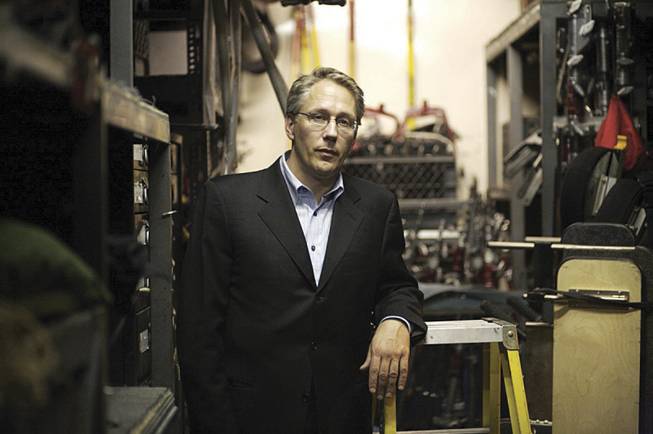
Publicity photo
Wade Bradley is founder and chief executive of IndieVest, a Los Angeles-based company that matches its members — relatively small investors — and producers of independent films, using pools of the investors’ money to finance the films. One of the company’s projects, “Saint John of Las Vegas,” starring Steve Buscemi, recently completed filming in New Mexico and Las Vegas.
Tuesday, Oct. 28, 2008 | 2 a.m.
“Saint John of Las Vegas” recently wrapped filming here, the latest of many independent films that have found their way to town in recent years.
Beyond the Sun
Indie icon Steve Buscemi portrays an ex-gambler who is lured back into the game by a veteran insurance-fraud investigator. Buscemi, known for roles in “Fargo,” “The Big Lebowski” and “Reservoir Dogs,” is no stranger to Las Vegas. He played a psycho killer in “Con Air,” the 1997 movie in which a planeload of convicts crashes on the Strip.
What is unusual about “Saint John of Las Vegas” is the way the $3.8 million film is being financed — by a pool of small-time investors.
It’s the first film produced by Indie-
Vest, a Los Angeles-based company that sells memberships to potential investors and matches them to projects.
“There are companies that fund films. But we develop, produce, fund and guarantee theater distribution in up to 1,500 theaters.” says IndieVest founder and Chief Executive Wade Bradley. “The IndieVest concept is similar to the management fee you pay if you join a hedge fund.”
Potential investors join IndieVest for membership fees ranging from $20 to $4,900 — the latter for an all-access membership that allows them to look at projects with top-tier talent already on board. “They decide whether they want to invest,” Bradley says. The minimum investment in a film is $50,000.
“Saint John” is expected to be screened at the Sundance Film Festival in January and to be released next year. The key to the success of any film is distribution, and Bradley says IndieVest has distributors with all the major theater chains.
IndieVest has 20 projects in various stages of development, Bradley says, and the company plans to make four to six films over the next year. The productions’ budgets will range from $3 million to $12 million.
“We’re not blowing up planes, it’s not nonstop action, although we can have a lot of action with the more modest budget,” Bradley says. “What we are looking at are compelling stories, unique subjects, engaging character portrayals, films with a phenomenal script that attract top talent who want to play the role.”
“Saint John of Las Vegas” fits that model. It’s the directorial debut of Hue Rhodes, who also wrote the screenplay, a loose adaptation of Dante’s “Inferno.” The script attracted stars such as Buscemi, comedian Sarah Silverman, Peter Dinklage (“The Station Agent”), John Cho (“Harold & Kumar”), Tim Blake Nelson (“O Brother, Where Art Thou?”) and Romany Malco (“The 40 Year Old Virgin”).
Most of the film was shot in Albuquerque, which lured the company with lucrative tax breaks. But the final scenes were filmed in Vegas.
One of the investors is Nick Radkowsky, 26, an artist from New York City. He was drawn to IndieVest because it was an investment that promised a nice return from something that stirs his passion.
“I love film. It is a large part of my life,” Radkowsky said during a phone interview. “I spent a lot of time with filmmakers from art school and watching them trying to get projects off the ground. A lot of issues of film financing are not covered in school.”
Radkowsky is a successful commercial artist and designer who also does consulting with public relations firms. He considers himself a sophisticated investor with a diverse portfolio, but this is his first venture into film. He researched how films are funded before he took his leap into the investment pool.
“They’re normally funded through private companies, large conglomerates like Universal or Disney,” Radkowsky said. “It’s like a clearinghouse situation. They produce tons of films and the successful ones subsidize the unsuccessful ones — which leads to a lot of infighting. It’s a Byzantine, very complicated system.”
Radkowsky invested in hedge funds several years ago, putting his money into a pool that he had no control over. “Investors didn’t know what projects they were investing in, which is fine,” he says. “A lot of investments work that way. You trust your financial investor to pick the right investments.”
But with IndieVest, Radkowsky knows what he’s investing in. If he doesn’t believe in the project, he doesn’t invest.
“To lose investment money in a credit default or something is one thing,” he said. “There’s a lot of difference in that and in investing in a film and being proud of what you created, regardless of the return on the investment.
“There’s a certain joy in building something you can be proud of.”
IndieVest has hidden advantages, Radkowsky says, such as networking.
“They don’t advertise it but inherent in the structure is the connection you make to the film community,” Radkowsky said. “I’ve met a few people and have worked on some projects that were unrelated to film.”

Join the Discussion:
Check this out for a full explanation of our conversion to the LiveFyre commenting system and instructions on how to sign up for an account.
Full comments policy